Click on images to enlarge
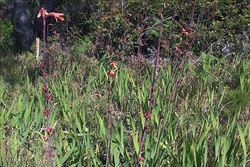
infestation (Photo: Jackie Miles)
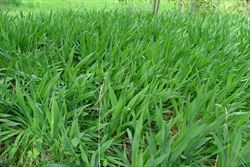
dense infestation (Photo: Sheldon Navie)
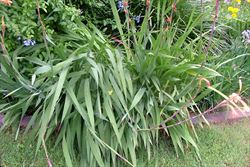
habit growing in a garden (Photo: Sheldon Navie)
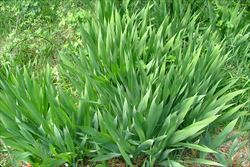
habit prior to flowering (Photo: Sheldon Navie)
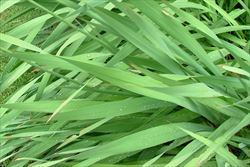
large strap-like leaves (Photo: Sheldon Navie)
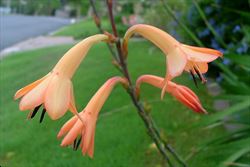
tubular curved flowers (Photo: Sheldon Navie)
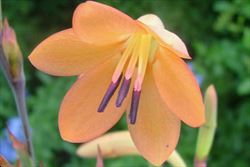
close-up of young flower showing three stamens (Photo: Sheldon Navie)
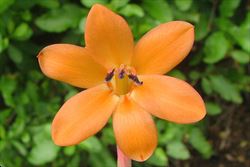
close-up of orange flower with six 'petals' and three dark stamens (Photo: Sheldon Navie)

close-up of flower from side-on, showing the relatively short 'petal' lobes (Photo: Sheldon Navie)

clusters of 'bulbils' produced below the old flowers (Photo: Sheldon Navie)
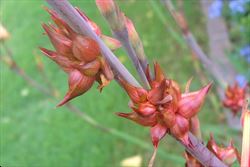
close-up of stem and reddish-brown 'bulbils' (Photo: Sheldon Navie)
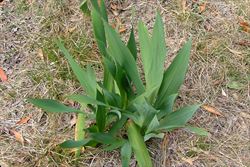
new growth from 'bulbs' in spring (Photo: Sheldon Navie)
Scientific Name
Watsonia meriana (L.) Mill. var. bulbillifera (J. Mathews & L. Bolus) D.A. Cooke
Synonyms
Watsonia angusta Ker Gawl. (misapplied)Watsonia bulbillifera J. Mathews & L. BolusWatsonia meriana (L.) Mill.Watsonia meriana (L.) Mill. 'Bulbillifera'
Family
Iridaceae
Common Names
bugle lily, bulbil bugle lily, bulbil bugle-lily, bulbil watsonia, Merian's bugle lily, watsonia, wild watsonia
Origin
Native to southern Africa (i.e. western Cape Province in South Africa).
Cultivation
Bulbil watsonia (Watsonia meriana var. bulbillifera) has been widely cultivated as a garden ornamental, particularly in temperate regions. It may still occasionally be seen growing in gardens.
Naturalised Distribution
Widely naturalised in southern and eastern Australia (i.e. in south-eastern Queensland, the coastal and sub-coastal districts of eastern New South Wales, southern and central Victoria, Tasmania, south-eastern South Australia and the coastal and sub-coastal districts of south-western and southern Western Australia). It has also been recorded once in tropical northern Queensland
Also naturalised in New Zealand and south-western USA (i.e. California).
Habitat
A weed of roadsides, railways, gardens, grasslands, open woodlands, waterways, pastures, coastal environs, disturbed sites and waste areas in temperate and sub-tropical regions.
Habit
An upright (i.e. erect) and long-lived (i.e. perennial) herb usually growing 100-180 cm tall, but occasionally reaching up to 2.5 m in height. This plant grows each year from underground 'bulbs' (i.e. corms), then dies back after flowering.
Distinguishing Features
- a long-lived herbaceous plant emerging each year from underground corms and growing up to 2 m tall.
- its upright flowering stems are often reddish its very large leaves (50-80 cm long and 1-5 cm wide) are strap-like in appearance.
- its tubular flowers are widely spaced along an elongated spike (20-40 cm long) at the tips of the stems.
- these orange, red or salmon pink flowers (5-8 cm long and 3-4 cm across) have six fused 'petals'.
- clusters of 4-16 small reddish-brown or brown shiny 'bulbs' (10-25 mm long and 5-7 mm across) are produced at the upper stem joints.
Stems and Leaves
The upright (i.e. erect), rounded, flowering stems (up to 20 mm thick) are often reddish in colour and are only rarely branched near their tips.
The very large leaves (56-110 cm long and 1-5 cm wide) are strap-like (i.e. linear) in shape with entire margins and pointed tips (i.e. acute apices). Most of the leaves arise from the base of the plant, but a few smaller leaves are alternately arranged along the stems. These leaves are sheathed (i.e. their bases enclose the stem), hairless (i.e. glabrous), and have prominent veins that run lengthwise (i.e. parallel veins).
Flowers and Fruit
The numerous, tubular, flowers (5-8 cm long and 3-4 cm across) are borne along an elongated spike (20-40 cm long) at the tips of the stems. These flowers (10-15 on each spike) are orange, red or salmon pink in colour (rarely pink or purple), slightly curved, and have six partially fused 'petals' (i.e. perianth segments or tepals). They are stalkless (i.e. sessile), subtended by small leafy bracts (15-25 mm long), and are quite widely spaced along the spike (about 3-4 cm apart). Each flower also has three stamens, with purplish anthers (about 10 mm long), and an ovary topped with a three-branched style, with each style branch being forked again near its tip. Flowering occurs mainly during spring and early summer (i.e. from October to December).
Fruit (i.e. capsules) and seeds are generally not produced in Australia. Instead, clusters of small reproductive structures (known as cormils or bulbils) are produced at the upper stem joints (i.e. nodes). These 'bulbils' are reddish-brown or brown in colour (10-25 mm long and 5-7 mm across), shiny in appearance, and have a short curved beak. Four to sixteen of these 'bulbils' are produced in each cluster.
Reproduction and Dispersal
This species reproduces vegetatively via underground 'bulbs' (i.e. corms) and smaller 'bulbs' (i.e. bulbils or cormils) on the stems. The underground corms (4-8 cm across) sprout 1-3 new smaller 'bulbs' during each season, which readily become detached from the parent corm. Seeds are not produced.
Corms may be dispersed during soil moving activities (e.g. road grading), by water, and in dumped garden waste. The bulbils are also spread in dumped garden waste, by water, and by slashers and other vehicles.
Environmental Impact
Bulbil watsonia (Watsonia meriana var. bulbillifera) is regarded as a significant environmental weed in Victoria, South Australia and Western Australia, and as an environmental weed in New South Wales, Tasmania and south-eastern Queensland. It is actively managed by community groups in South Australia and Western Australia and was recently listed as a priority environmental weed in four Natural Resource Management regions.
Legislation
This species is declared under legislation in the following states and territories:
- Victoria: C7 - all reasonable steps must be taken to control the weed and prevent its spread (in the Glenelg, Corangamite, Port Phillip West, Port Phillip East, North East, East Gippsland and West Gippsland regions).
- South Australia: 5* - this species is declared under Class 5c and control of this species is required in part of the state only.
- Western Australia: Prohibited - on the prohibited species list and not permitted entry into the state.
Management
For information on the management of this species see the following resources:
- the Victorian Department of Primary Industries Landcare Note on this species, which is available online at http://www.dpi.vic.gov.au.
- the Environmental Weed Action Network website at http://members.iinet.net.au/~ewan/.
Similar Species
Bulbil watsonia (Watsonia meriana var. bulbillifera) is very similar to several other cultivated watsonias (Watsonia spp.) that have also become naturalised (e.g. Watsonia aletroides, Watsonia marginata, Watsonia versfeldii and Watsonia borbonica). However, none of these other species produce the distinctive 'cormils' that are found on the flowering stems of bulbil watsonia (Watsonia meriana var. bulbillifera).
This species is also relatively similar to African cornflag (Chasmanthe floribunda) and montbretia (Crocosmia x crocosmiiflora). However, they can be distinguished by the following differences:
- bulbil watsonia (Watsonia meriana var. bulbillifera) is a relatively large plant (usually 1-1.8 m tall) with very large leaves (50-80 cm long and 2-5 cm across). Its flowers have six stigmas and it rarely produces fruit (instead it produces clumps of distinctive 'cormils' at the upper stem joints).
- African cornflag (Chasmanthe floribunda) is a relatively large plant (usually about 1.5 m tall) with very large leaves (more than 80 cm long and 2-4 cm across). Its flowers have three stigmas and the uppermost 'petal lobe' is significantly longer than the others.
- montbretia (Crocosmia x crocosmiiflora) is a relatively small plant (usually up to 60 cm tall) with smaller leaves (rarely more than 20 mm across). Its flowers have three stigmas and they are arranged along the stalk in a somewhat zig-zagged pattern.

